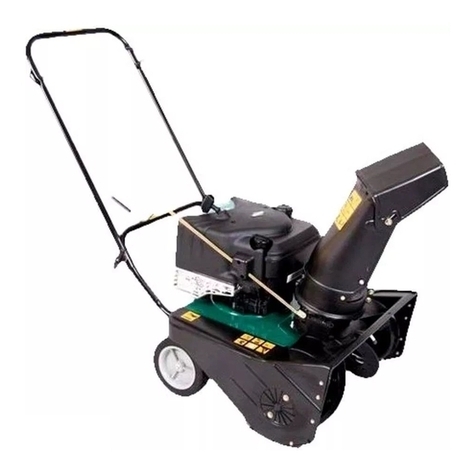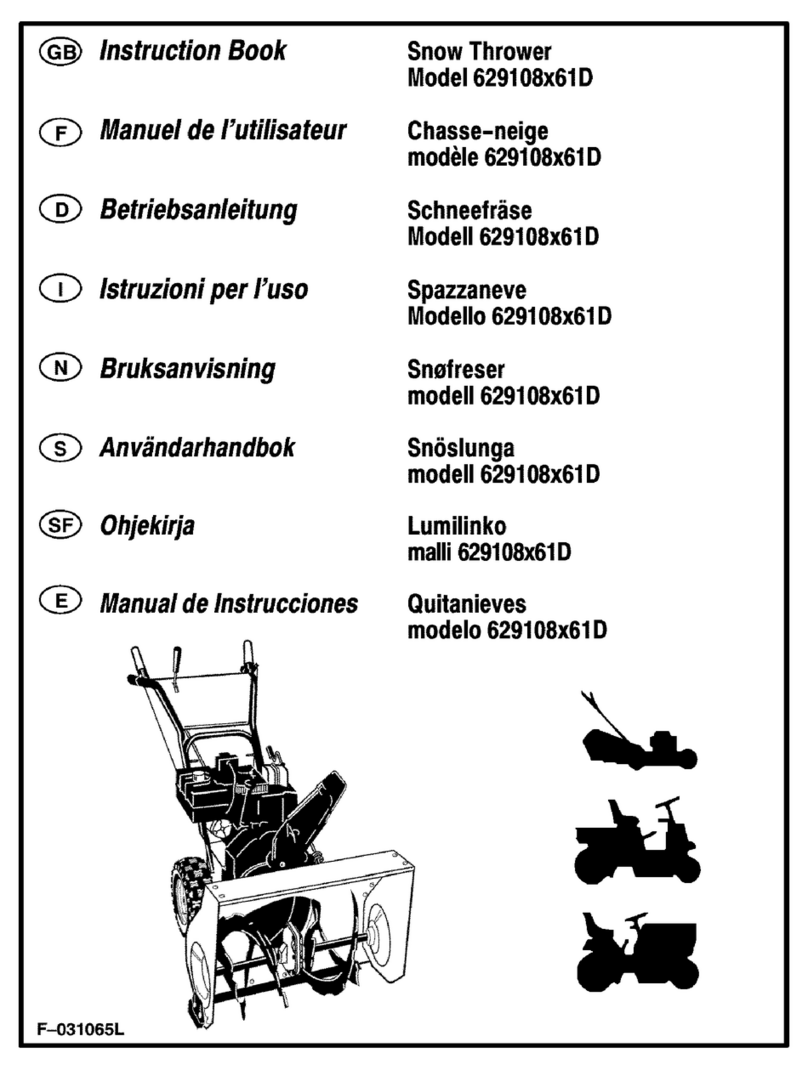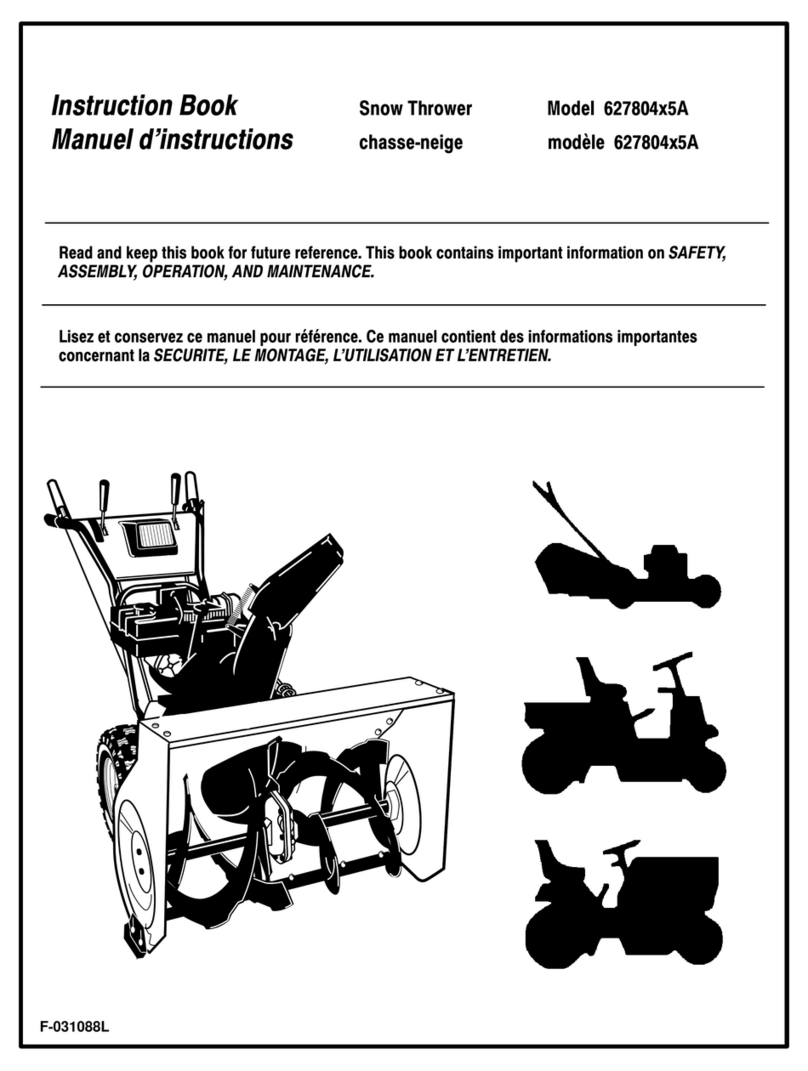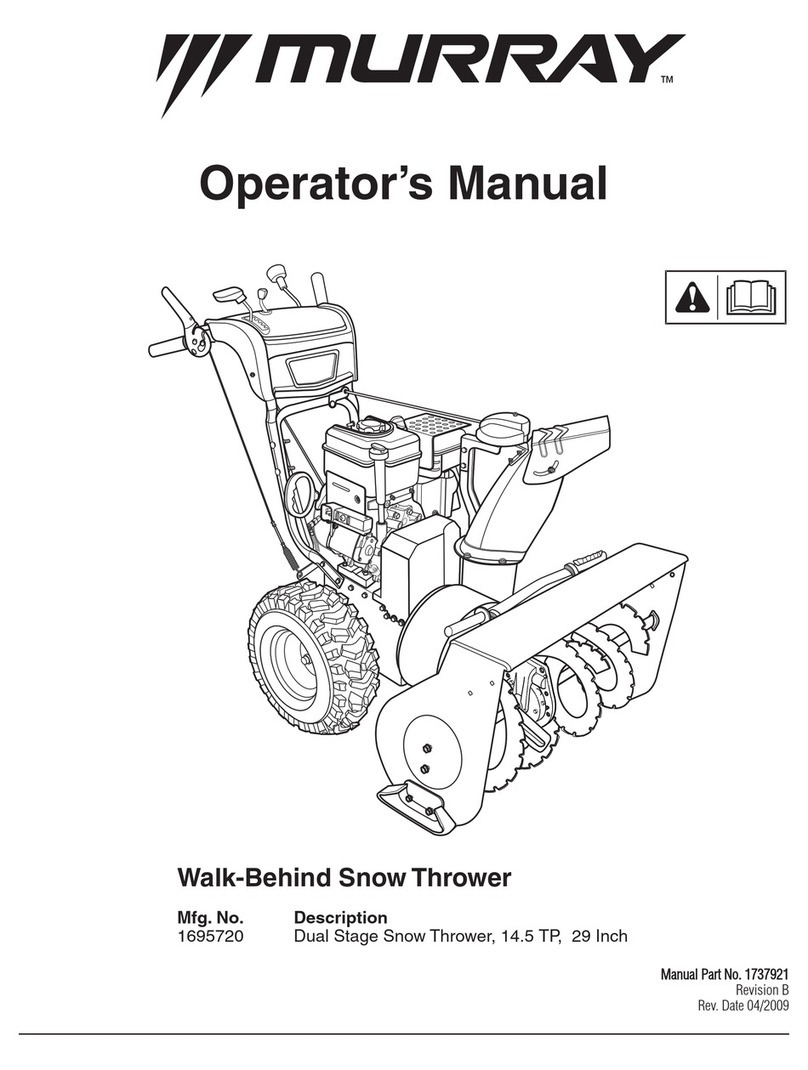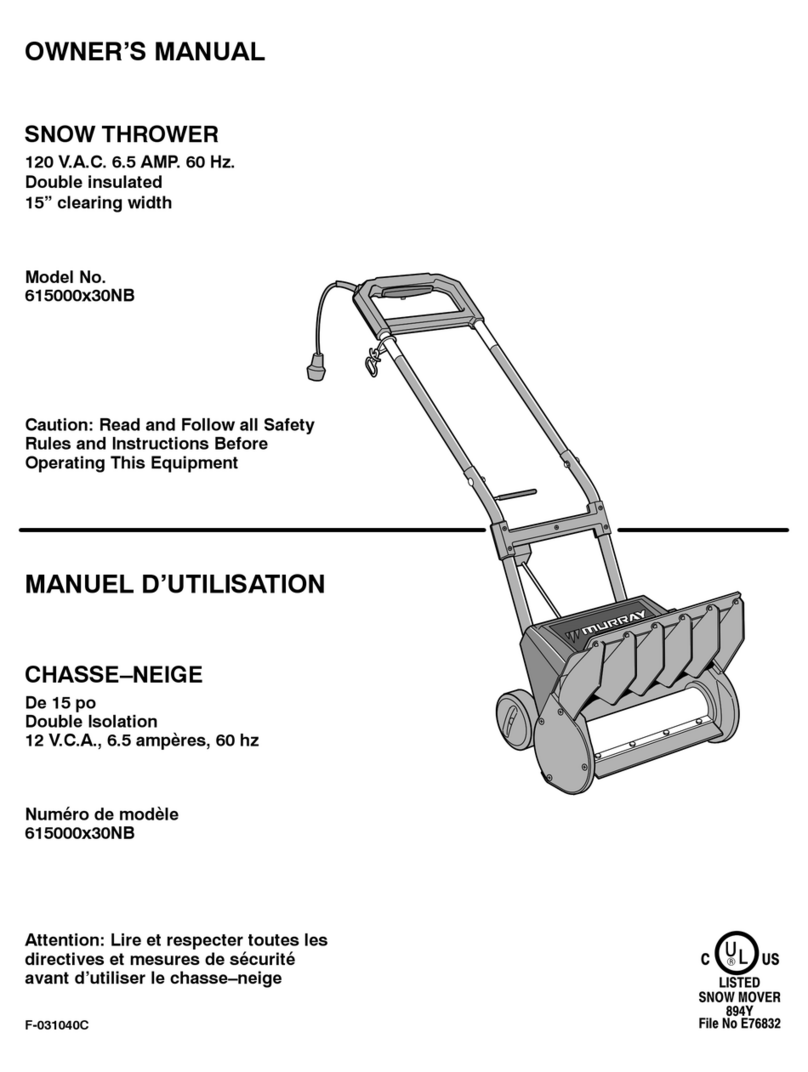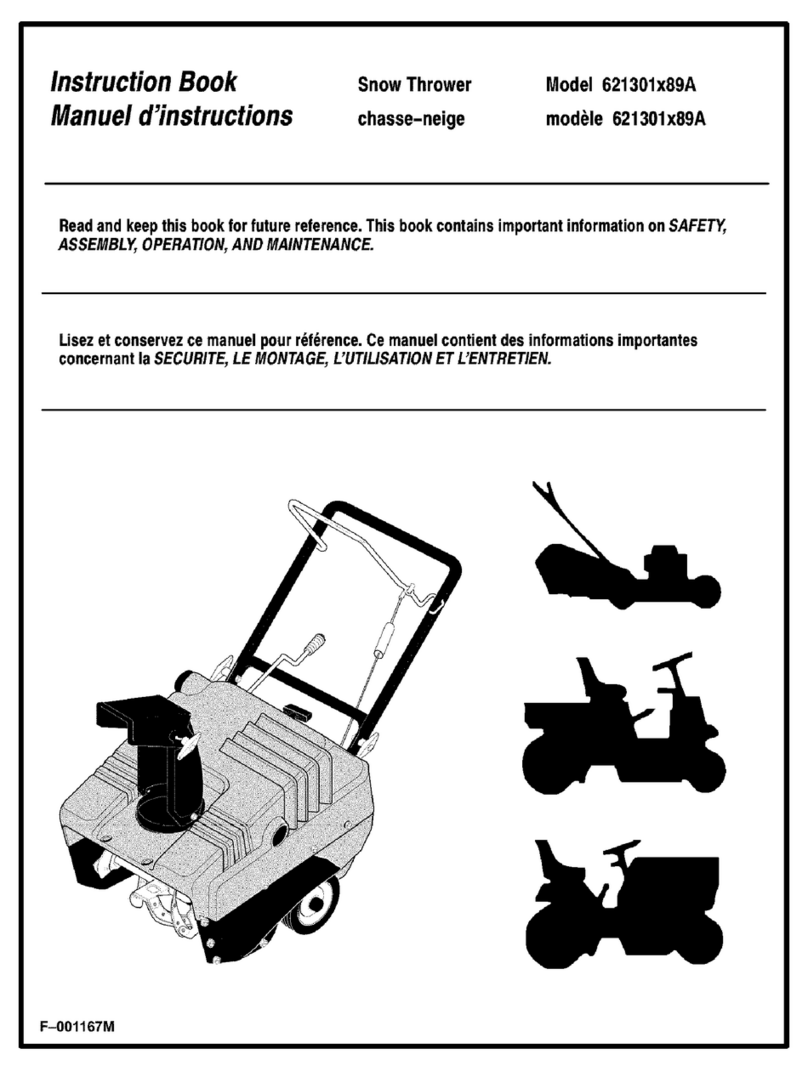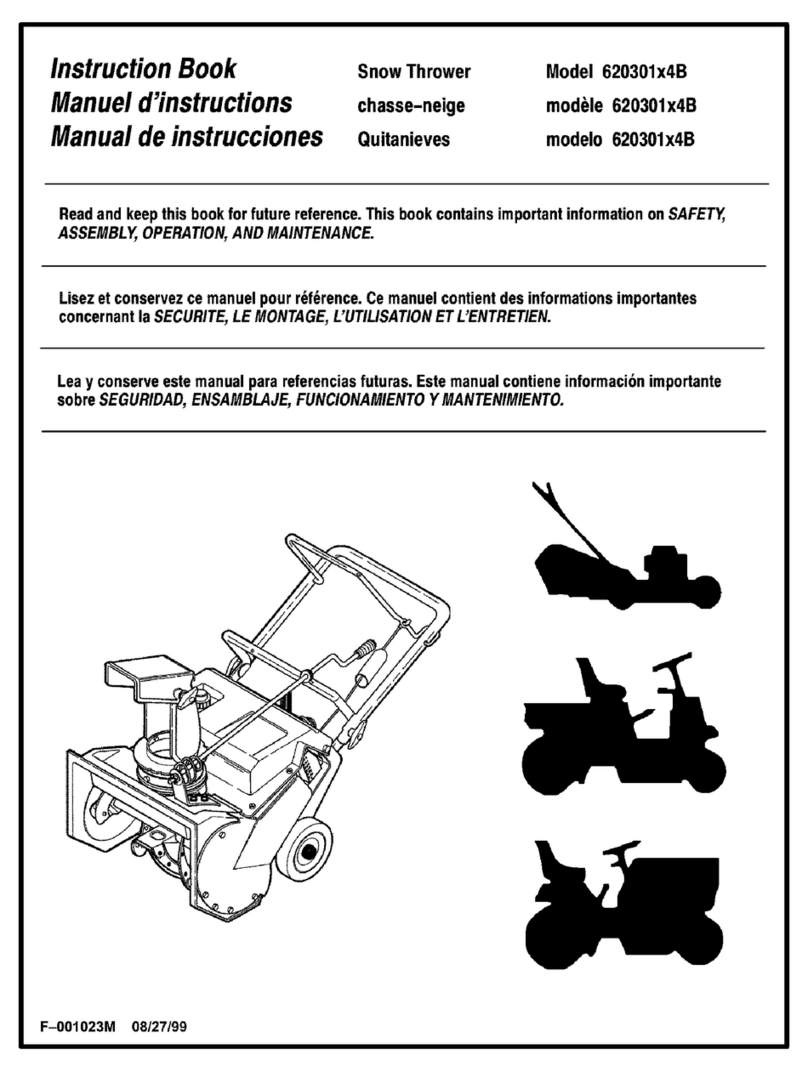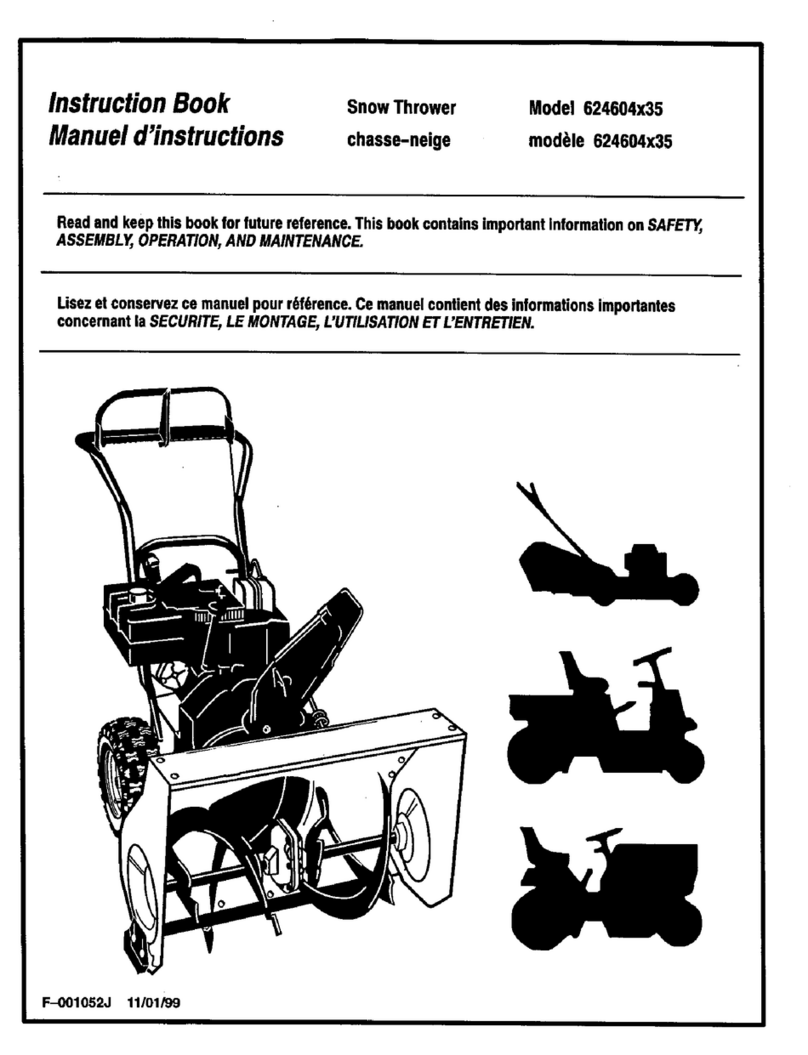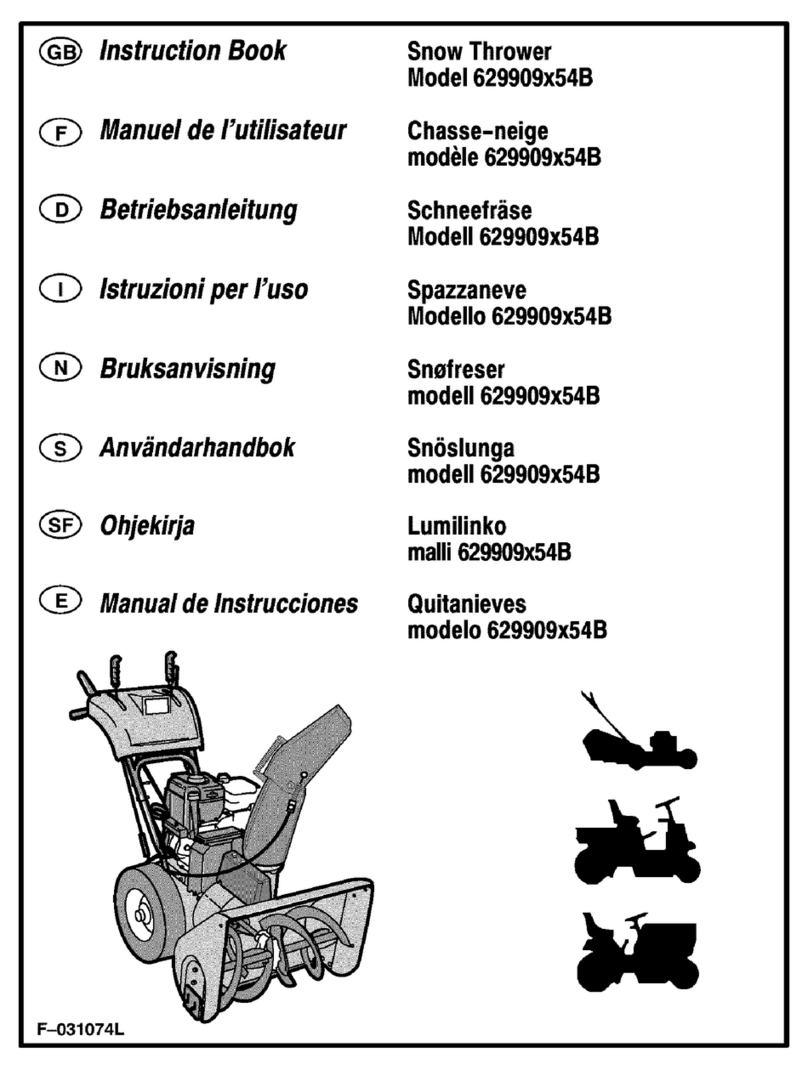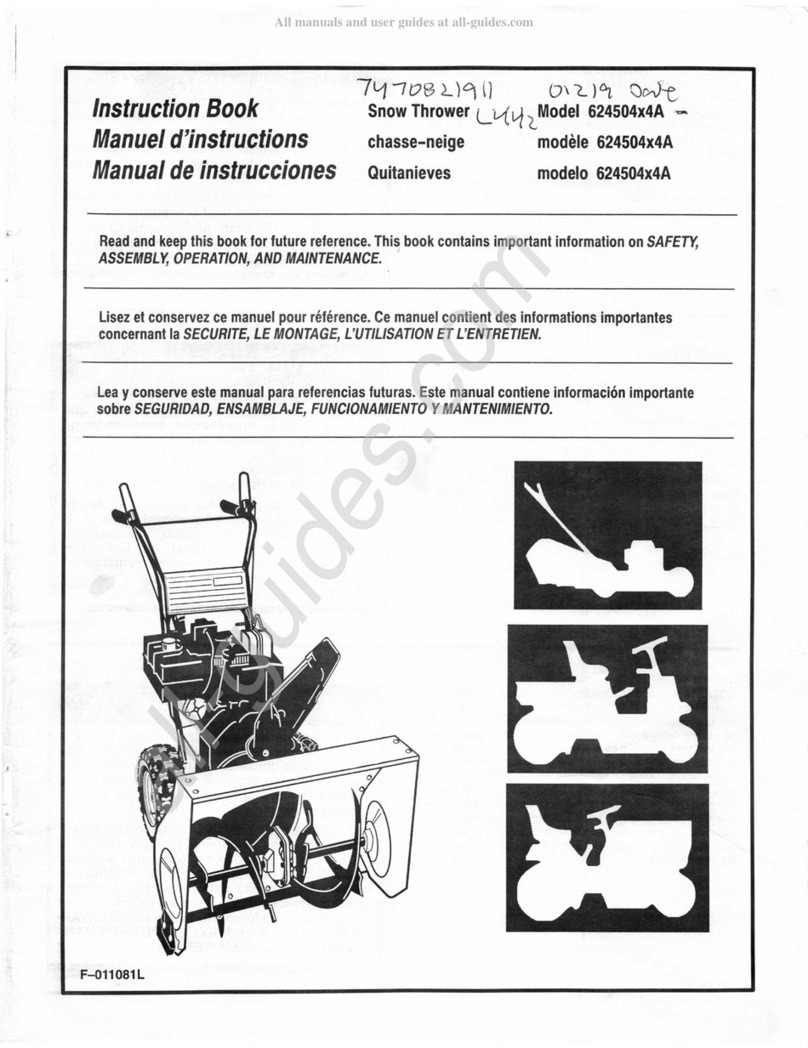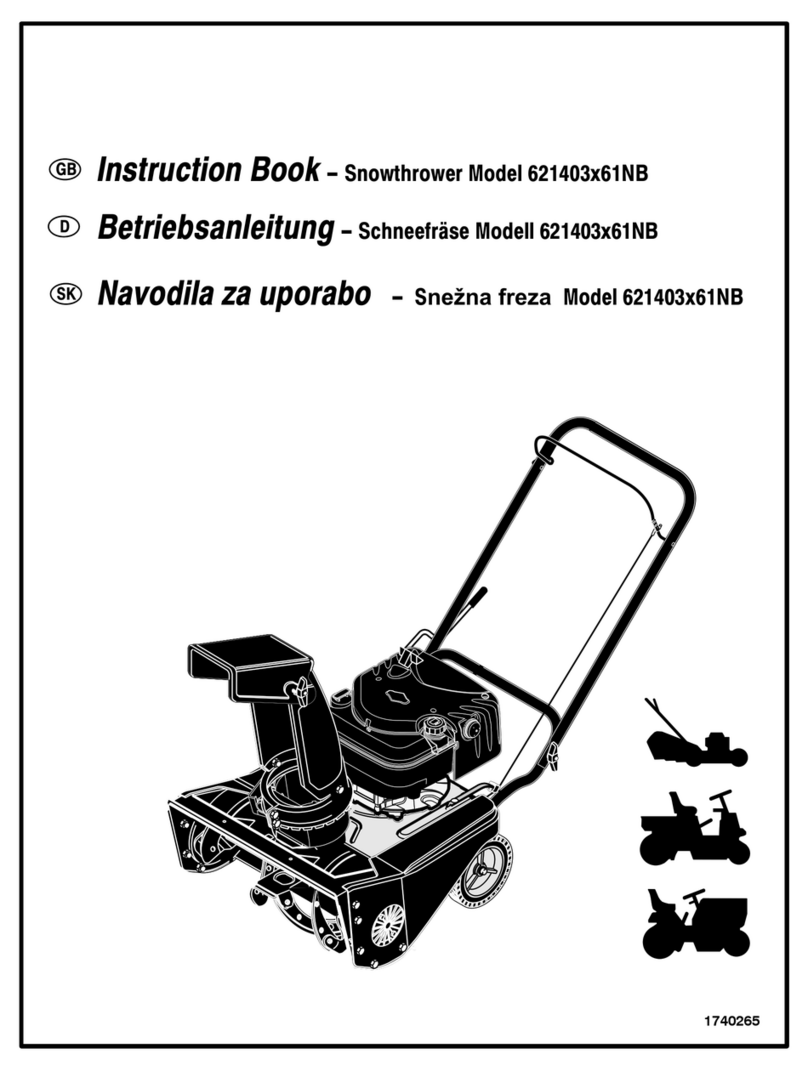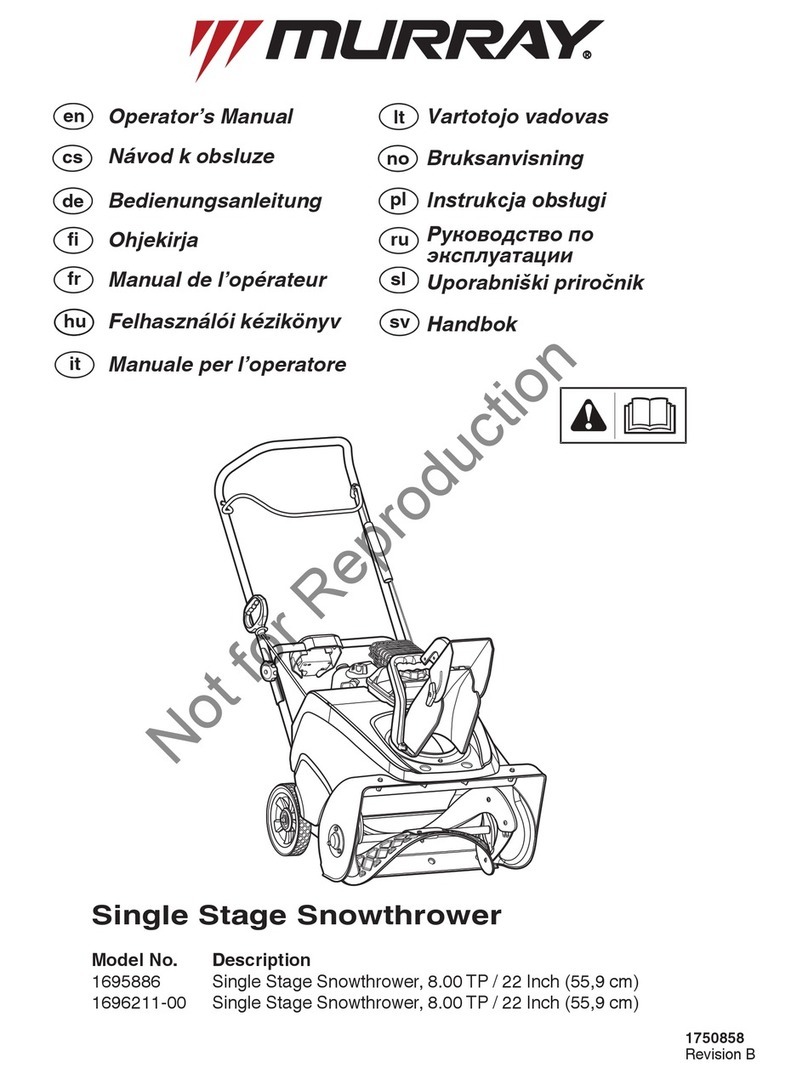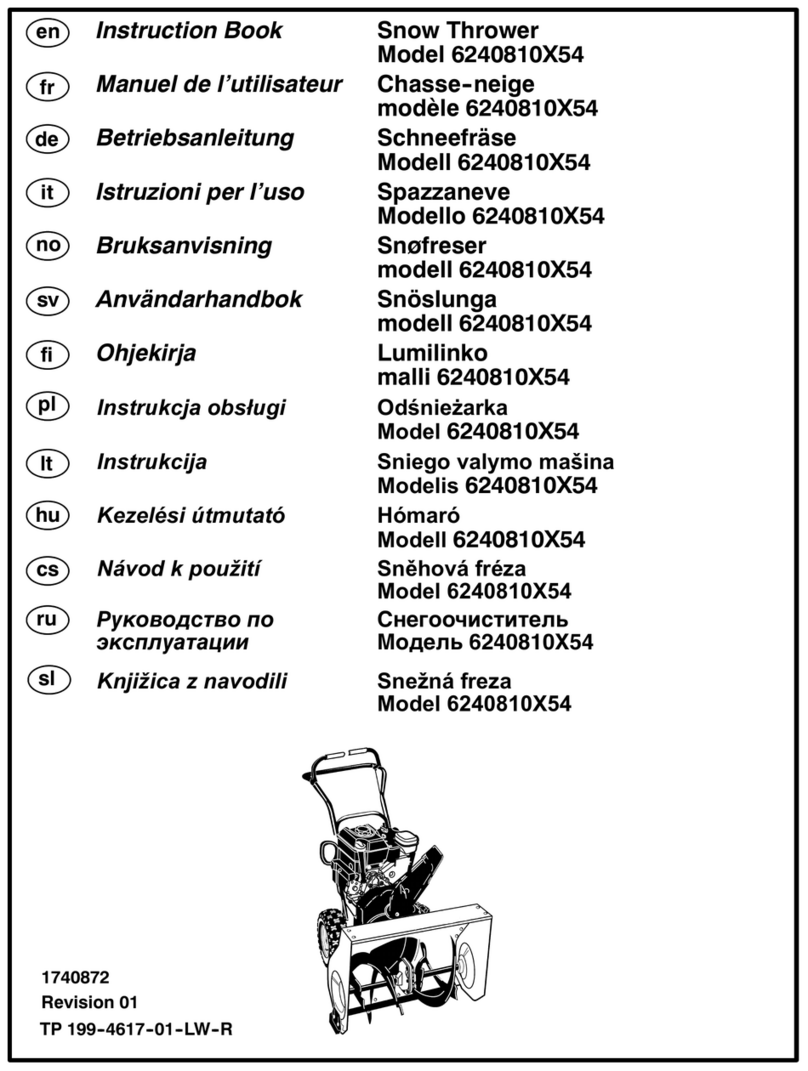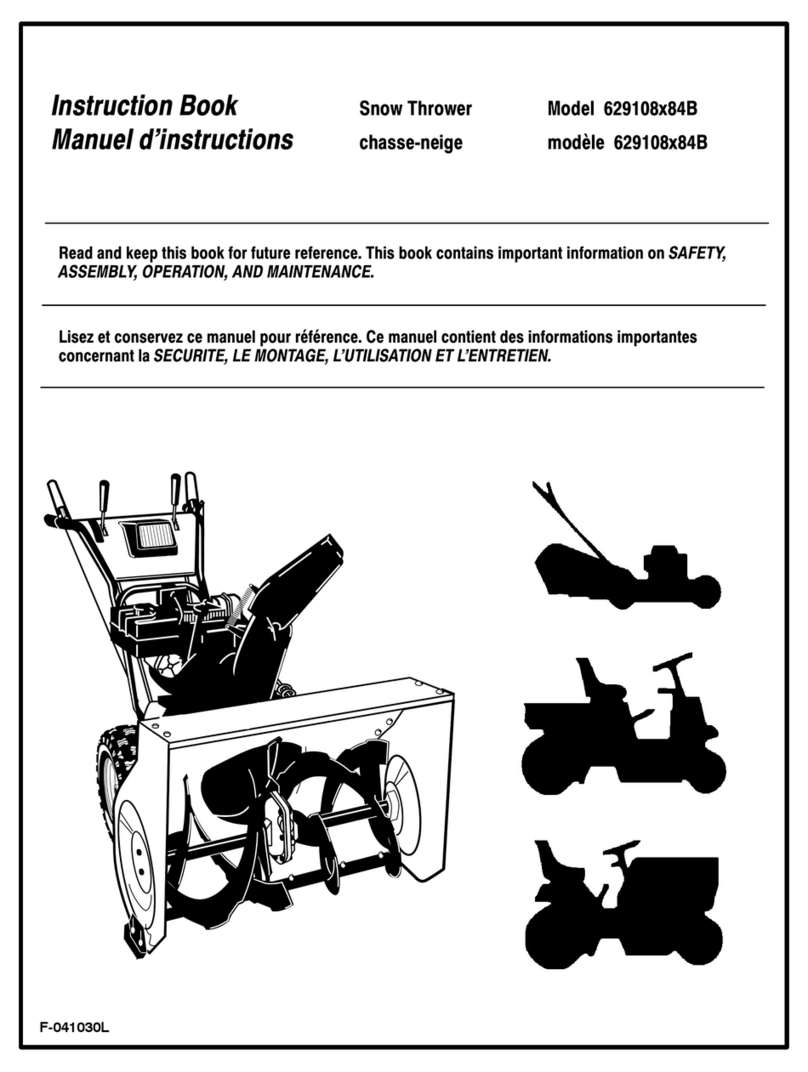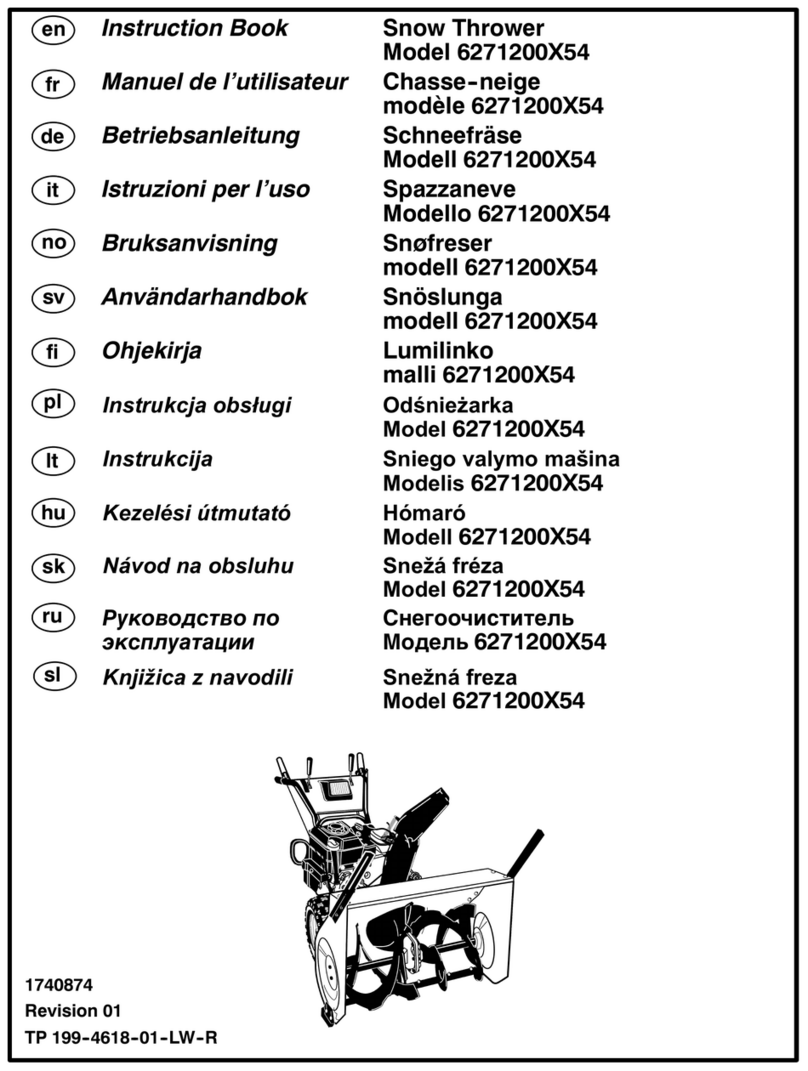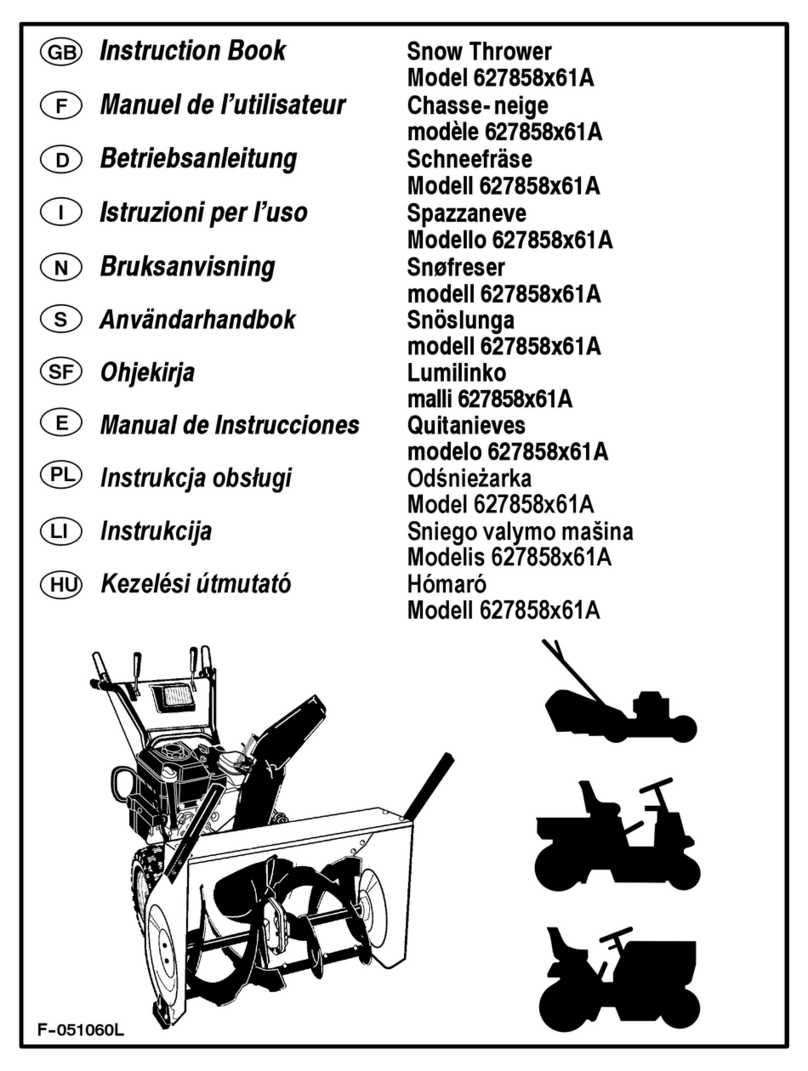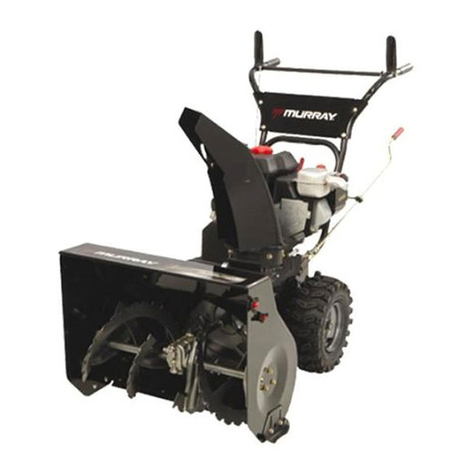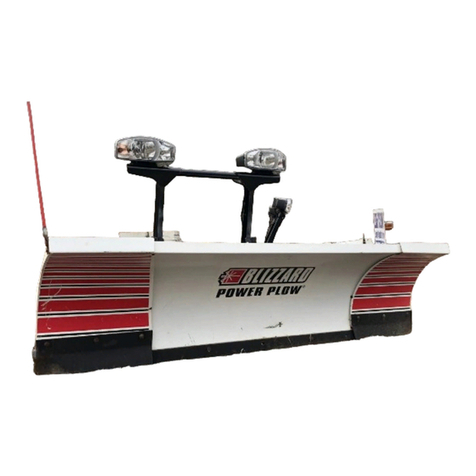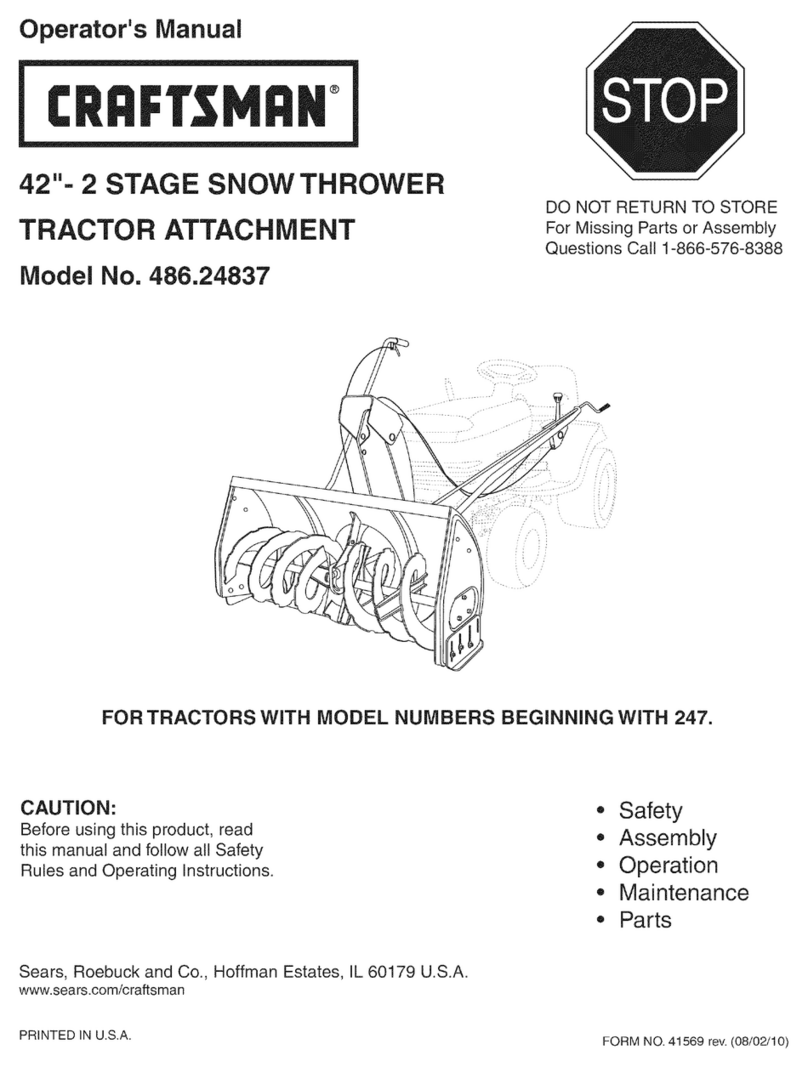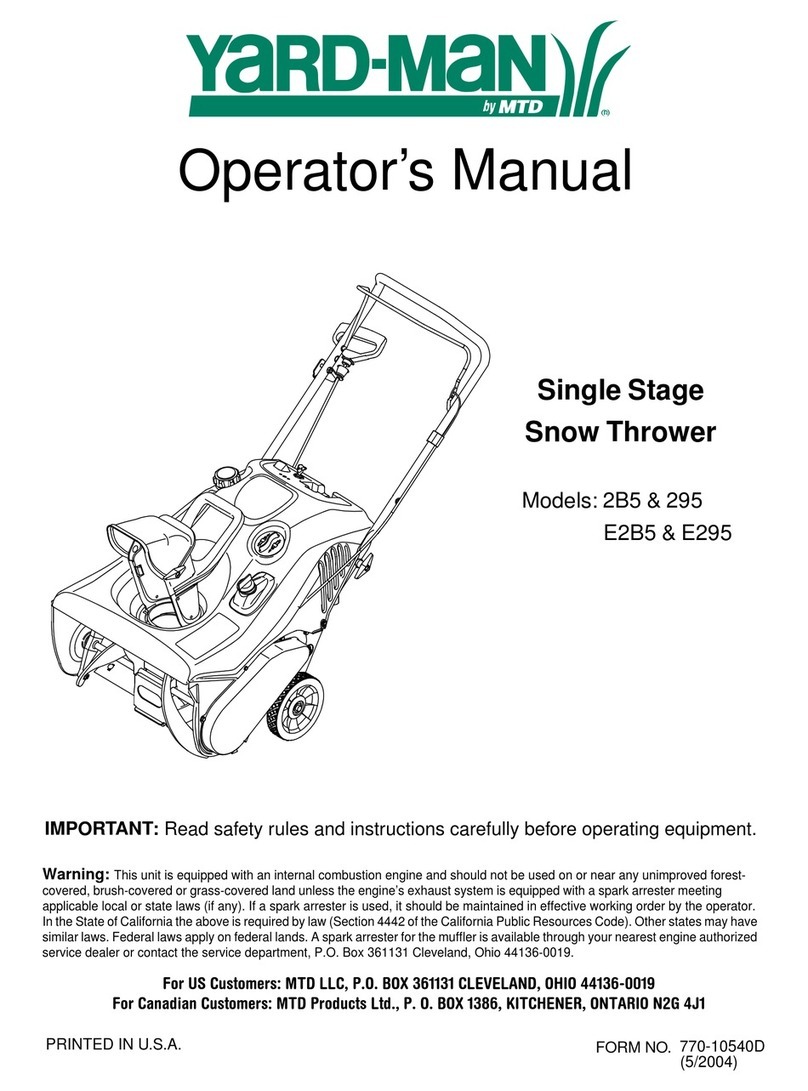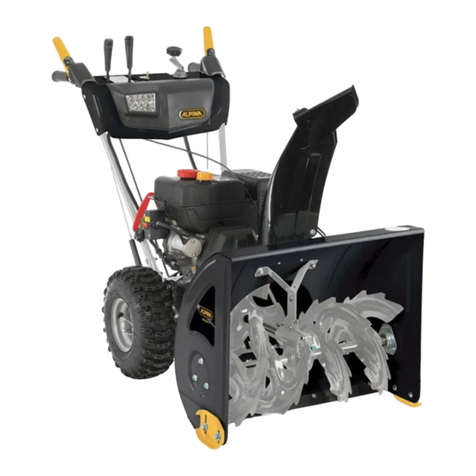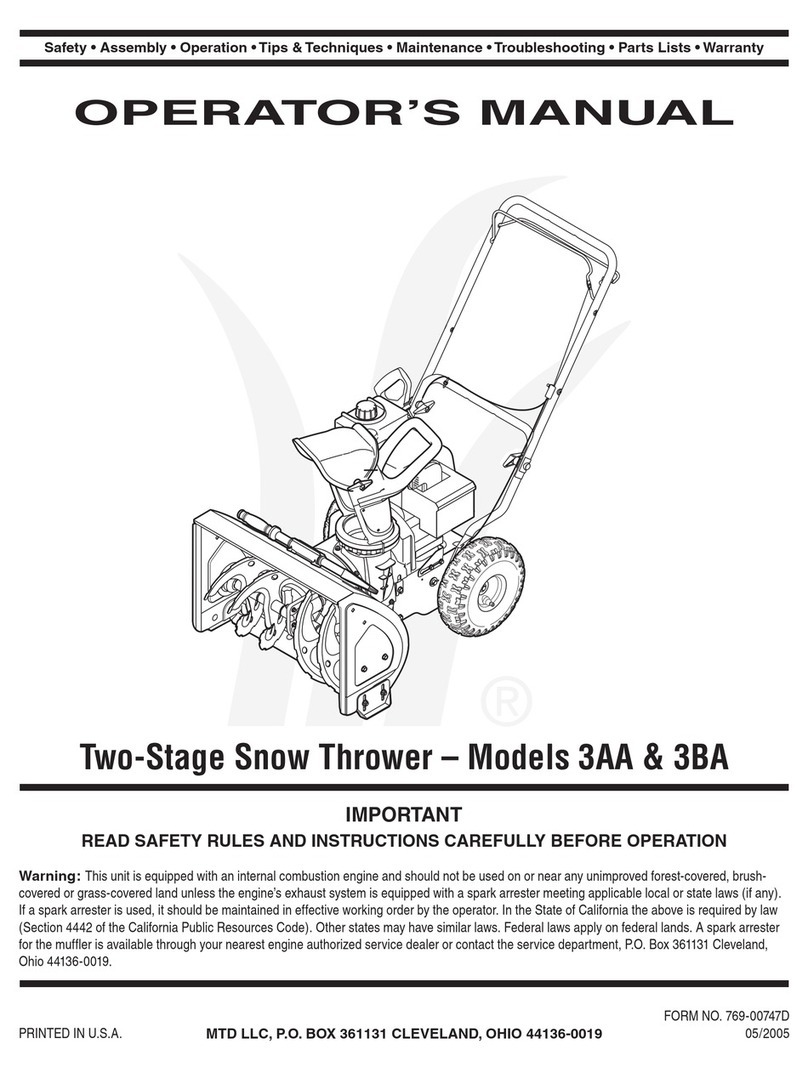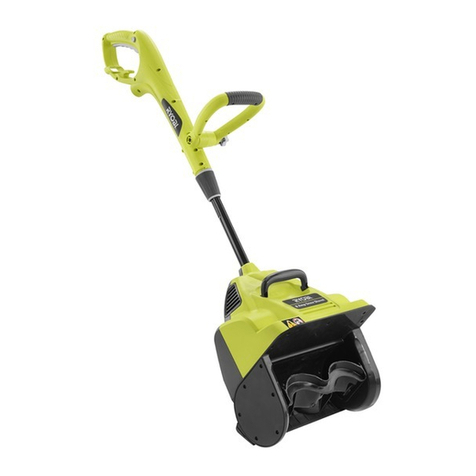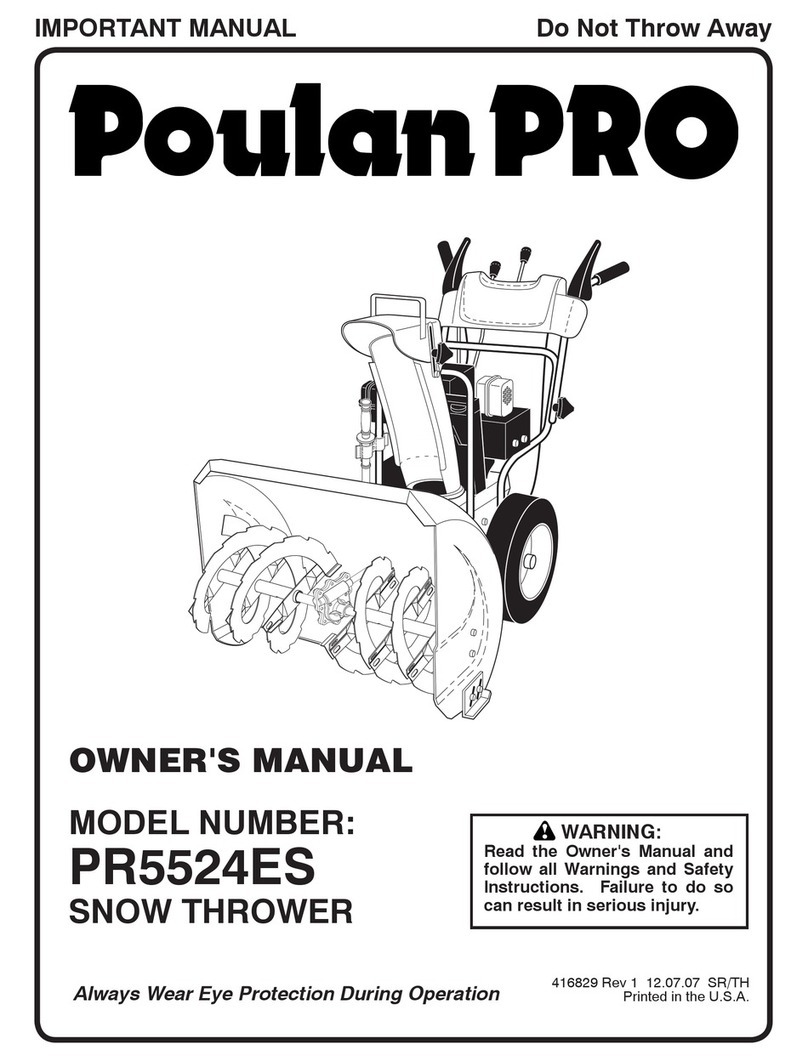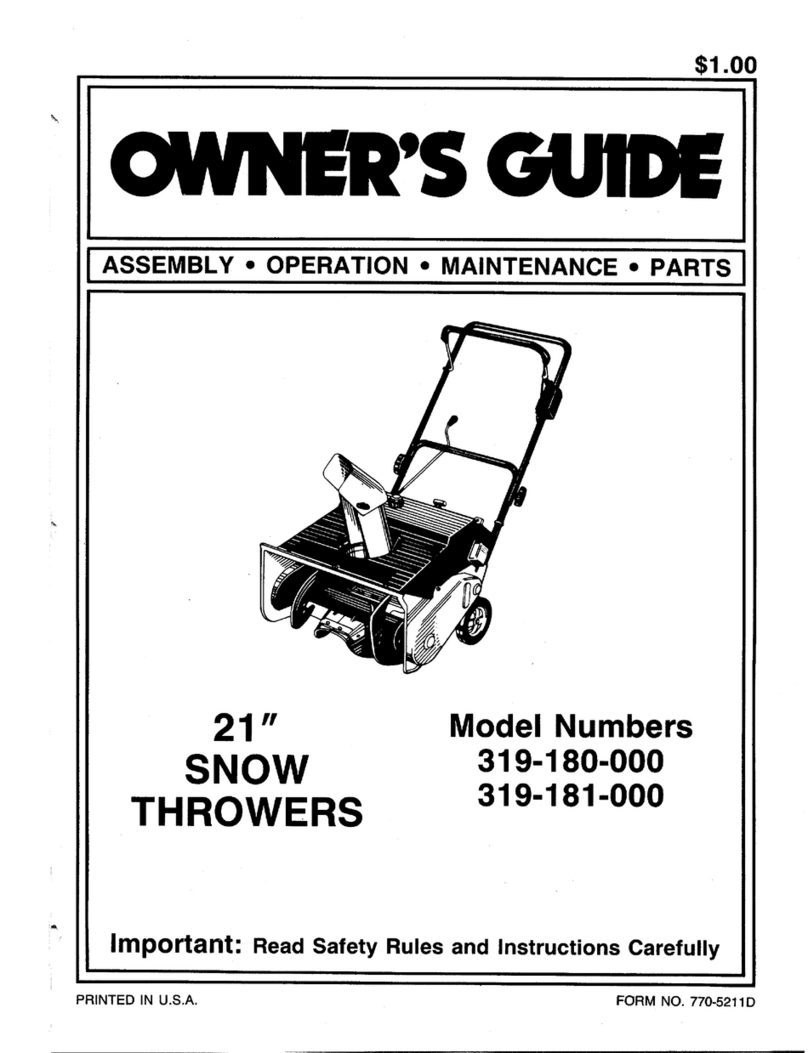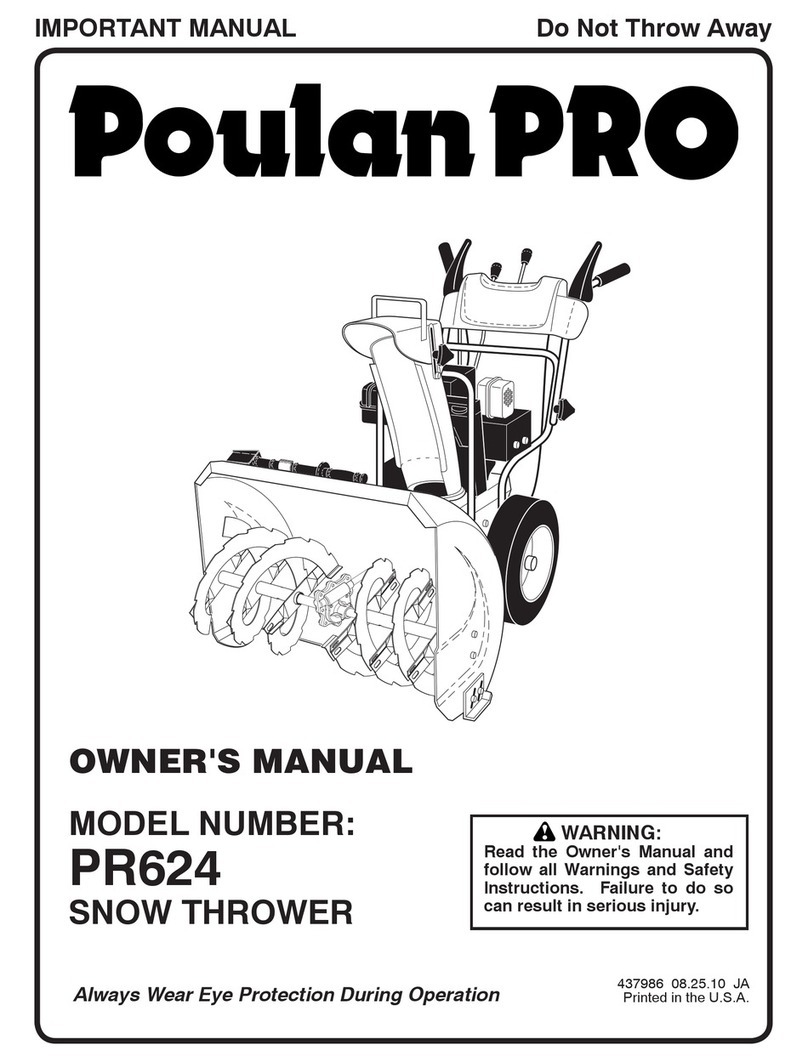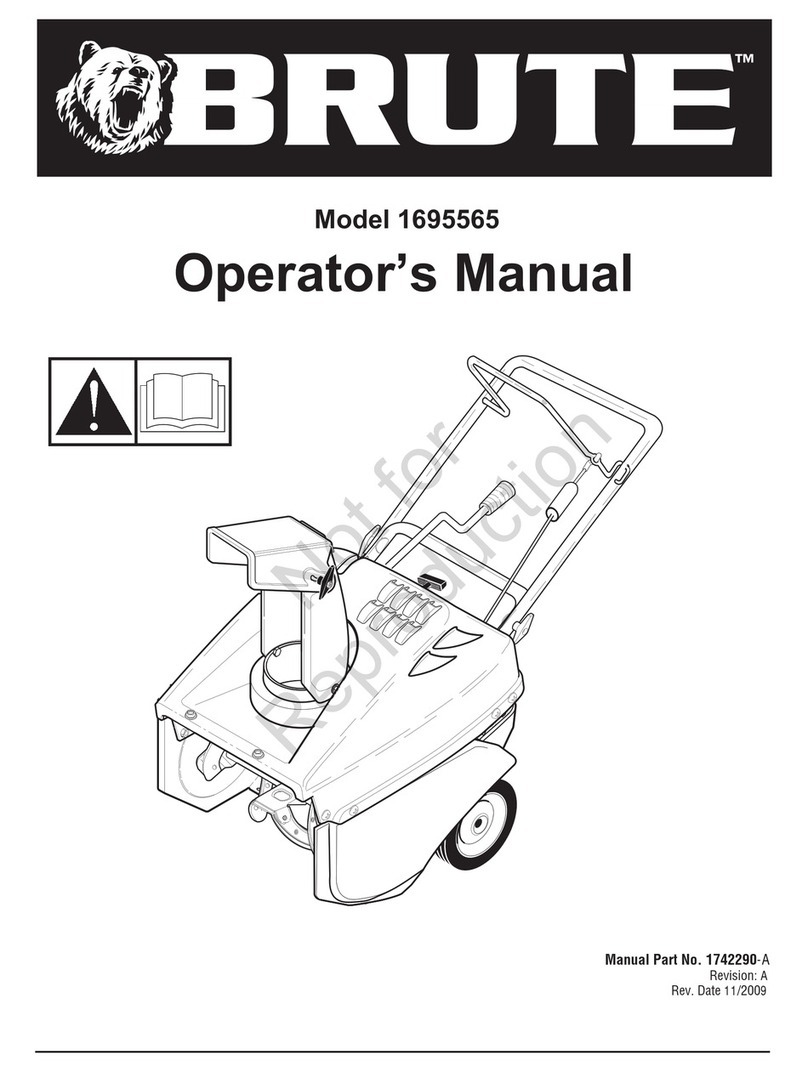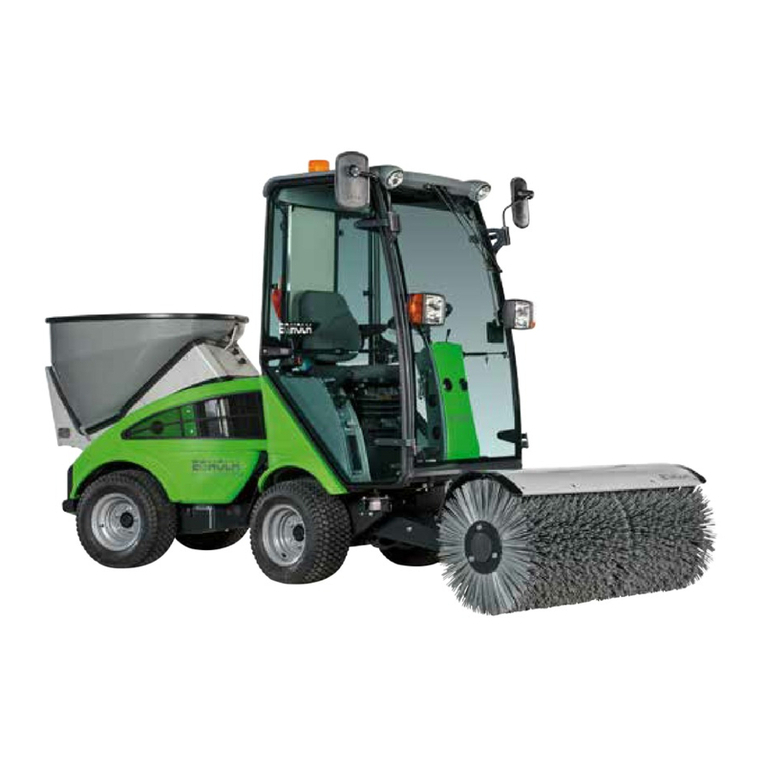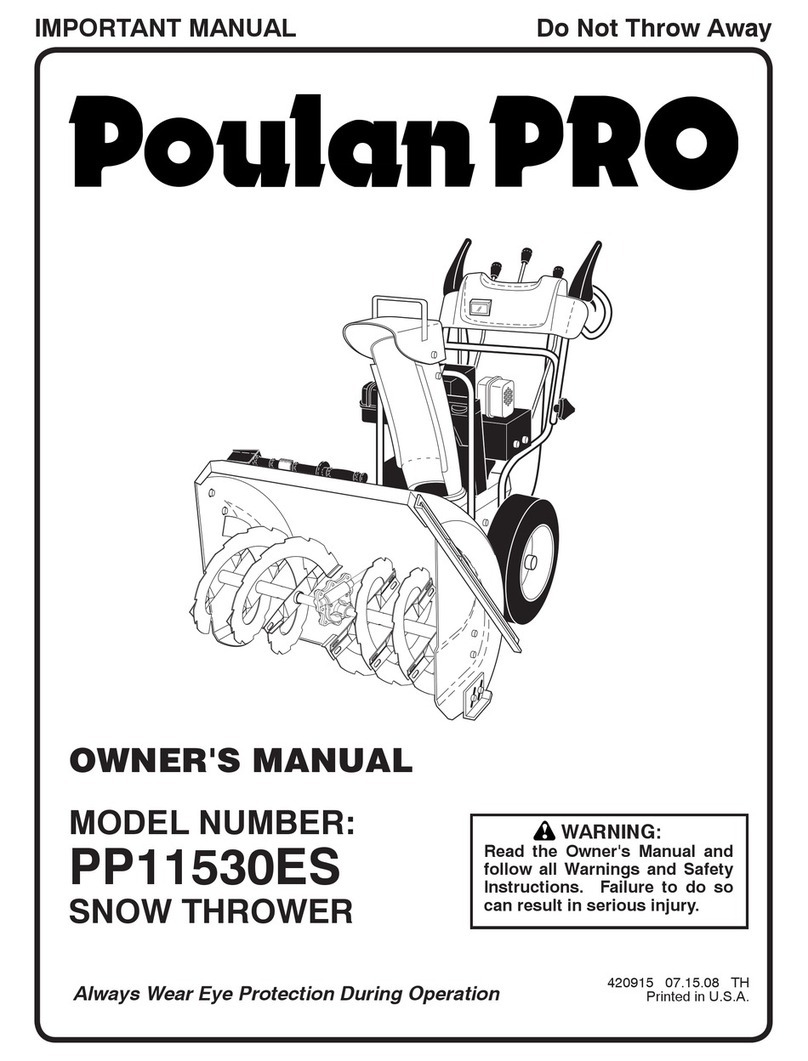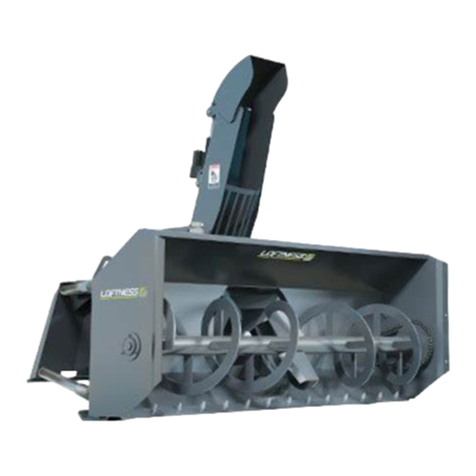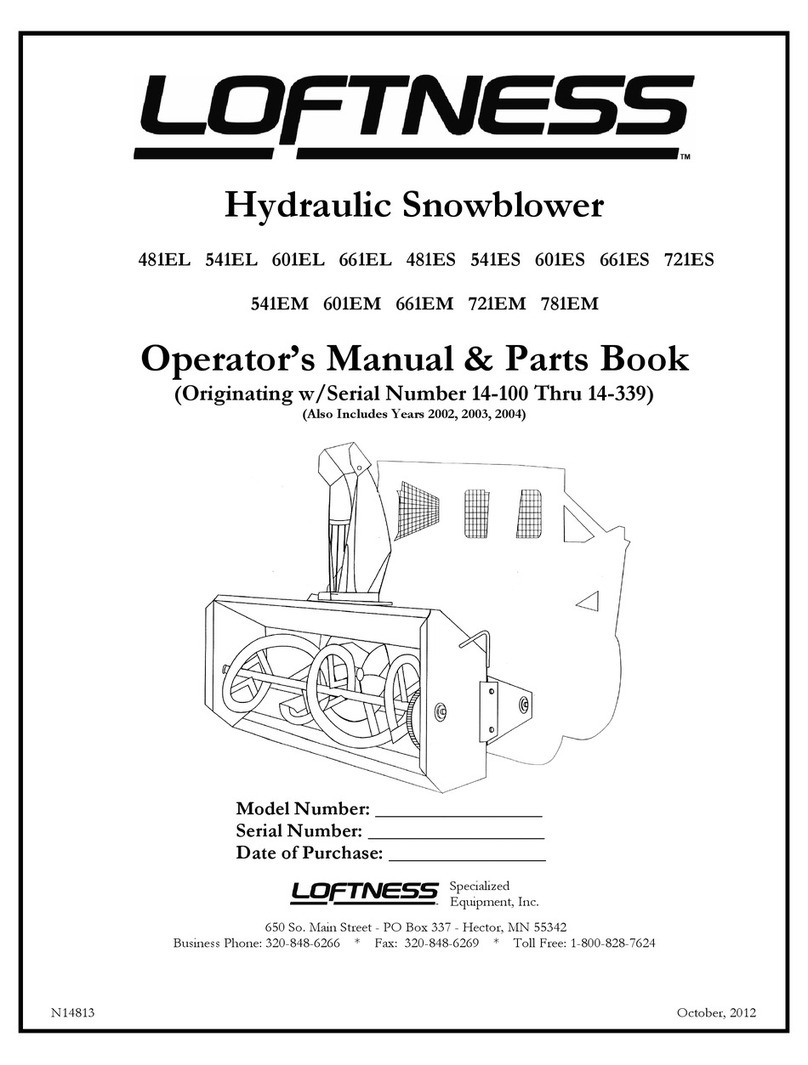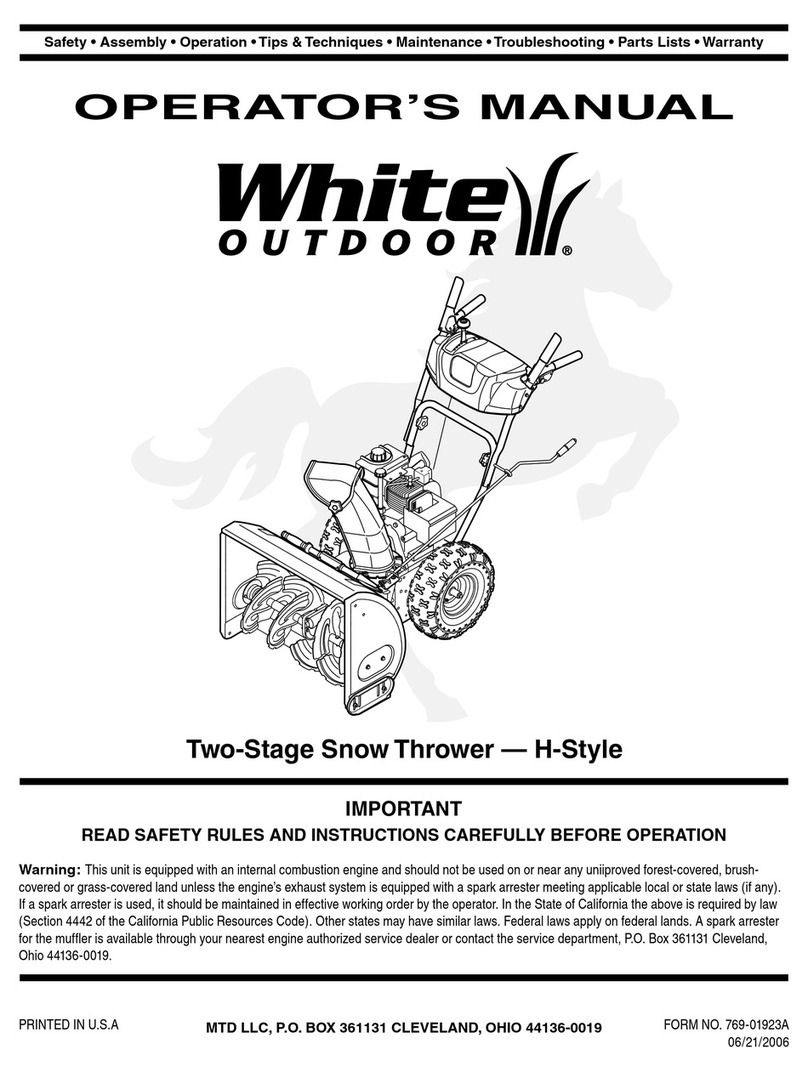OPERATION
NOTE: Illustrations begin on page 3.
Know Your Snow Thrower (Figure 2)
Read this Instruction Book and safety rules be-
fore operation the snow thrower. Compare the
illustration with your snow thrower to familiarize
yourself with the location of various controls and
adjustments.
Crank Assembly (2) - Changes the direction of
the discharge chute.
Discharge Chute (3) - Changes the distance the
snow is thrown.
Auger Drive Lever (5) - Starts and stops the au-
ger which propels the snow thrower.
Ignition Key (8) - Must be inserted and turned to
the on position to start the engine.
Primer Button (9) - Injects fuel directly into the
carburetor for fast starts in cold weather.
Electric Start Button (10) -On electric start mod-
els, used to start the engine.
Switch Box (11) - On electric start models, used
to attach a 120 volt electric power cord.
Recoil Starter Handle (12) - Use to manually
start the engine.
Choke Control (14) - Use to start a cold engine.
Spark Plug Access Panel (15) - Remove to ac-
cess the spark plug.
How To Control
The Discharge Of The Snow
WARNING: Never direct the dis-
charge of snow toward bystanders.
WARNING: Always stop the engine
before unclogging the discharge
chute or the auger housing and be-
fore leaving the snow thrower.
1. (Figure 2) Turn the crank assembly (2) to
change the discharge direction of the snow.
2. (Figure 3) Loosen the wing knob (1) on the
chute deflector (2).
3. Move the chute deflector (2) up for more
distance or down for less distance.
4. Tighten the wing knob (1).
How To Throw Snow (Figure 2)
1. Engage the auger drive lever (5).
2. To stop throwing snow, release the auger
drive lever (5).
WARNING: The operation of any
snow thrower can result in foreign
objects being thrown into the eyes,
which can result in severe eye damage.
Always wear safety glasses or eye shields
while operating the snow thrower. We rec-
ommend standard safety glasses or use a
wide vision safety mask over your glasses.
F-021003C
How To Stop Discharging Snow
(Figure 2)
1. To stop discharging snow, release the auger
drive lever (5).
2. To stop the engine, turn the ignition key (8)
to the off position.
How To Move Forward (Figure 4)
1 Hold the auger drive lever (5) against the
handle (2). The auger will begin rotating.
2. To go forward, raise the handle (2) to allow
the rubber auger blades (1) to contact the
ground. Maintain a firm hold on the handle
(2) as the snow thrower starts to move for-
ward. Guide the snow thrower by moving the
handle (2) either left or right. Do not attempt
to push the snow thrower.
3. To stop, release the auger drive lever (5).
NOTE: If the auger continues to rotate, see
"How To Adjust The Auger Control Cable" in
the Service and Adjustments section.
Before Starting The Engine
1. Before you service or start the engine, famil-
iarize yourself with the snow thrower. Be
sure you understand the function and loca-
tion of all controls.
2. Make sure that all fasteners are tight.
3. Make sure the fuel tank is filled with the cor-
rect mixture of gasoline and oil.
4. Become familiar with the location of atl con-
trols and understand their function.
5. Before starting the engine, make sure all
controls operate cerrentty.
Add The Fuel Mixture
WARNING: Follow the engine
manufacturer's instructions for the
type of fuel and oil to use. Always
use a safety fuel container. Do not smoke
when adding the fuel mixture to the engine.
When inside an enclosure, do not fill the
fuel tank. Before you add the fuel mixture,
stop the engine. Let the engine cool for
several minutes.
(Figure 4) Fill the fuel tank (3) to the full posi-
tion with a fresh, clean fuel mixture. See "How
To Mix The Fuel Mixture" in the Assembly sec-
tion.
How To Stop The Engine (Figure 2)
To stop the engine, turn the ignition key (8) to
the off position. Keep the ignition key (8) in a
safe place. The engine wiII not start without the
ignition key (8).
How To Start The Engine (Figure 2)
Models equipped with an Electric Starter
NOTE: An electric starter kit can be added to
recoil start engines, Electric starter kits are
available from your nearest authorized ser-
vice center. 10
ENGLISH
WARNING: The starter is equipped
with a three-wire power cord and
plug and is designed to operate on
120 volt A.C. household current. The power
cord must be properly grounded at all times
to avoid the possibility of electrical shock
which can injure the operator. Carefully fol-
low all instructions in the "How To Start The
Engine" section. Make sure that your house
wiring is a three-wire grounded system. If
you are not sure, ask a licensed electrician.
If your house wire system is not a
three-wire grounded system, do not use
this electric starter under any conditions. If
your system is grounded but a three-hole
grounded receptacle is not available to start
the engine, have a three-hole grounded re-
ceptacle installed by a licensed electrician.
To connect a 120 volt A.C. power cord, al-
ways connect the power cord to the switch
box (11) on the engine first. Then, plug the
other end into the three-hole grounded re-
ceptacle. When disconnecting the power
cord, always unplug the end from the
three-hole grounded receptacle first.
How To Start A Cold Engine (Figure 2)
1. Fill the fuel tank with a fresh, clean fuel mis-
ture. See "How To Mix The Fuel Mixture" in
the Assembly section.
2. Move the choke control to FULL position.
3. Make sure the auger drive lever (5) is in the
disengaged (released) position.
4. Insert the ignition key (8) and turn to the on
position.
5. Move the choke control (14) to the full
choke position.
6. (Electric Start) Connect the power cord to
the switch box (11) located on the engine.
7. (Electric Start) Plug the other end of the
power cord into a three-hole, grounded 120
VOLT, A.C. receptacle. (See the WARNING
in this section).
8. Push the primer button (9). Every time you
push the primer button (9), wait two sec-
onds. For the number of times required to
push the primer button (9), see the engine
manufacturer's instructions.
9. (Electric Start) Push on the electric start
button (10) until the engine starts. Do net
crank for more than 10 seconds at a time.
The etectric starter is thermally protected. If
the electric starter overheates, it will auto-
matically stop and can only be restarted
when it has cooled to a safe temperature. A
wait of about 5 to 10 minutes is required to
allow the electric starter to cool.
10. (Recoil Start) Rapidly pull the recoil starter
handle (t2). Do not allow the recoil starter
handle (12) to snap back. SlewIy return the
recoil starter handle (12).
11. If the engine does not start in 5 or 6 tries,
See the "Trouble Shooting Chart" Instruc-
tions.
12. (Electric Start) When the engine starts, re-
lease the electric start button (10) and
move the choke control (14) to 1/2 choke
position. When the engine runs smoothly,
move the choke control (14) to the off posi-
tion.
13. (Electric Start) First disconnect the power
cord from the three-hole receptacle. Then,
disconnect the power cord from the switch
box (11).
